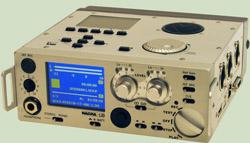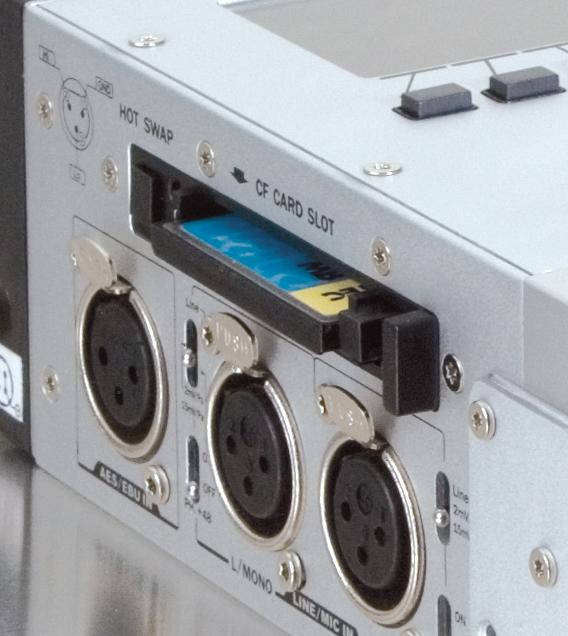
René Laflamme, chez Fidelio music nous parle d’un appareil qu’il affectionne particulièrement et utilise pour réaliser ses belles prises de son :
Après l’enregistreur Nagra VI (6 canaux) voici le Nagra LB (2 Canaux, 24bits/192kHz)

Tarif : $3280 CAN
Trophée lors du dernier SATIS
Après le NAGRA V c’est au tour du NAGRA LB de remporter un trophée lors du dernier SATIS.
Les entrées sont équipées des traditionnels préamplificateurs NAGRA pour microphones dynamiques ou pour microphones statiques alimentés en phantom +48V.
L’entrée ligne peut accepter jusqu’à +24dB.
Les niveaux audio et les fonctions en cours sont indiqués sur l’écran couleur sur la face avant de l’appareil.
Au-dessus des potentiomètres, trois leds indiquent également les niveaux audio, comme sur l’ARES-BB+ et le NAGRA VI.
La face avant de l’appareil devient inactive lorsque le mode « montage » sur le dessus de l’appareil est en fonction.
Le NAGRA LB est équipé d’une mémoire interne flash NAND de 2GB qui joue deux fonctions importantes.

Premièrement, elle fait office de sauvegarde lorsque la carte compact flash est pleine et doit être enlevée de l’appareil.
Mais elle sert également de mémoire tampon pour continuer l’enregistrement pendant que la carte amovible est changée.
En appuyant simplement sur la touche « Hot Swap » près du lecteur de carte, vous pourrez remplacer votre carte compact flash sans perdre de données, même en cours d’enregistrement.
La platine supérieure du NAGRA LB dispose d’un système complet de montage visualisé sur un second écran couleur sous une forme d’onde.
Une fois le montage terminé, le fichier pourra être transmis au studio soit par IP (en utilisant une connexion Internet), soit via un téléphone GSM équipé d’un système Bluetooth.
Bien entendu, le port USB permet également à l’appareil d’être reconnu comme un disque externe lorsqu’il est connecté à un ordinateur pour le transfert des fichiers.
Le port USB « hôte » peut également être utilisé pour connecter un périphérique de stockage externe afin de transférer les fichiers.
Le NAGRA LB est alimenté par 8 piles ou batteries rechargeables « AA » (LR6) dans un boîtier amovible. Les batteries peuvent être rechargées via le connecteur Hirose situé sur ce boîtier.
Two channel Universal digital audio recorder
Features/ Caractéristiques
2 channels
24 bit, 192 kHz AD / DA MPEG-1 layer II
MP-3 compression
Compact flash and internal 2GB flash memory
On-board graphic audio editor
USB 2.0 and Ethernet communication ports
Internal speaker
Pre-recording buffer
Dual colour screens and Bluetooth communication Lightweight and battery operated
Product description/Description du produit
The NAGRA LB has been designed as the natural successor to the ARES-C and the ARES-BB+ recorders, and it is specifically designed for broadcast applications although naturally it is also very well suited to a multitude of other recording applications.
Similar in size to the ARES-BB+ the LB offers communication possibilities never before seen in a professional broadcast recorder.
Audio inputs/Entrées audio
It offers two analogue audio inputs and a single stereo digital input. The Nagra LB will record in either PCM linear audio or in MPEG-1 layer II or MP-3 compressed audio formats.
The inputs are equipped with traditional NAGRA microphone pre-amplifiers for dynamic and phantom +48V microphones. The LINE input will accept up to +24dB.
The audio levels and current operating mode of the recorder are shown on the colour display mounted on the front of the unit.
Above the potentiometers three leds are fitted to indicate audio levels as on the ARES-BB+ and Nagra VI.
The front display becomes inactive when the editor on the top panel of the machine is in use.
The built-in microphone can also be seen in the top left corner of the photograph.
Media
The Nagra LB is fitted with an internal 2GB NAND flash memory which serves two important roles.
Firstly as a back-up media should the extractable compact flash card be full, but also as a spontaneous memory for recording while the extractable card is changed.
Simply pressing the “Hot Swap” button next to the slot will allow the card to be replaced even while the recorder is actually recording.
Editing and communication
The top of the LB is equipped with a full audio editing system with its own dedicated colour display. This allows in-the-field editing and gives a graphic waveform display.
Once the editing of the audio material is complete, the file can be transmitted to the studio either over IP (through the ethernet connection using the File Transfer Protocol “FTP” connection) or via a GSM phone through the Bluetooth option.
Naturally the USB port also serves as a generic drive when connected to a computer to file transfer can also be done this way. Removal of the compact flash card is a final possibility for removing the audio from the recorder.
The HOST USB port can also be used for an external memory stick for file transfer.
The LB is powered by 8 “AA” batteries in a removable battery compartment. This may be fitted with rechargeable cells if required, which are in turn charged through the Hirose connector on the battery box body using the built-in charger circuit.
Technical Specifications/Spécifications techniques
Recording/enregistrement
Internal storage 2 GB NAND Flash memory
Removable media Compact Flash type II / III (Hot Swappable)
Disk format FAT 16 / 32
Recording Method Linear digital PCM, MPEG 1 layer 2 or MP-3
File type 16 / 24 bit Broadcast Wave File BWF (WAV)
A/D & D/A conversion 24 Bit Sigma Delta
Bit rates 32 kbits/s up to 384 kbits/sec
Tracks 2 individual
Sampling Rate 44.1, 48 kHz, 88.2, 96 and 192kHz
Recording capacity 1hr 24 bit 48 kHz per GB of disk / memory
Pre-recording buffer Programmable (Maximum 3 seconds)
Display 2 x Colour LCD
Level meters On colour display AND by LED
Inputs/Entrées
Digital input XLR 3-pole
Analogue inputs
2 x XLR Microphone (Dynamic, +48V Phantom) / line
Microphone input sensitivity 2 and 15 mV/Pa selectable
Limiters On microphone inputs
Line input sensitivity Adjustable from -6 dBm up to +24 dBm for 0 dBFS recording
THD at 1 kHz <0.1% Mic, <0.01% line (measured on AES out)
Frequency response Mic, 10Hz - 48 kHz ¡¾ 0.5 dB, Line ¡¾0.2 dB (measured on AES out)
Signal-to-noise ratio >100 dB
Input level adjustment range 50 dB Mic and from -6 to +24 dB Line
Input filters LFA (with vortex filtering)
Internal microphone Electret on the front panel
Outputs/Sorties
Analogue line output XLR 4.4V max (+15 dBm)
Digital output XLR AES-3 (24 bit or 16 bit)
Headphones Stereo 6.3mm (¨ù¡±) Jack 50 ¥Ø
Internal speaker 0.2W
Other/Autres
USB Host USB 2.0 connector type “A”
USB Device USB 2.0 connector type “B”
M/S Decoder Switchable
Ethernet RJ 45
General
Dimensions 175 x 65 x 185mm (W x H x D) (Incl. battery box)
Weight 1.4 kg (3 lbs) (Incl. batteries)
Power supply External 9 - 15V
Power Consumption Approximately 2W (160mA on 12V)
Charge time Approximately 3 hours (with NimH cells)
Battery life > 10 hours (8 “AA” Alkaline cells)
Relative humidity From 10% to 99% (non condensing)
Fidelio audio
René Laflamme
Tél : 514-273-4825
[email protected]
http://www.nagraaudio.com

